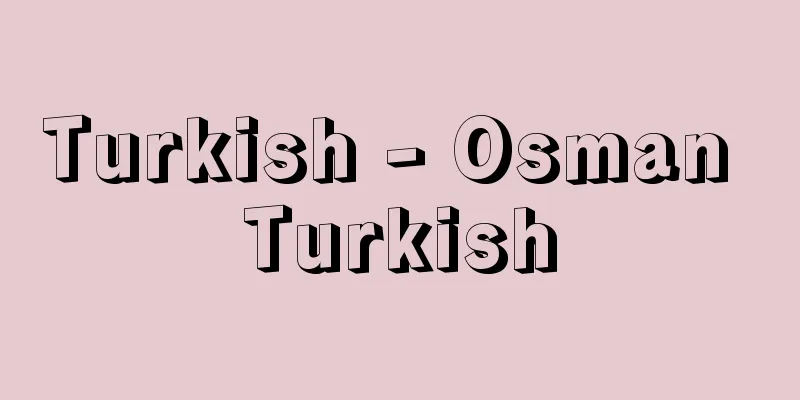Turkish - Osman Turkish

|
The language of the Republic of Turkey (population approximately 68 million). Formerly known as Ottoman Turkish, it is one of the major languages of the Turkic family. The Turkic languages are widely distributed from Eastern Siberia to Central Asia, and are closely related to each other to form the Turkic language family. Turkish belongs to the southern branch and is closely related to Azerbaijani and other languages. After the establishment of the Republic of Turkey (1923), the Arabic-Persian script that had been used until then was abandoned, and in 1928 the Roman alphabet was used. The 8 vowels and 21 consonants closely reflect the phonemes of Turkish, so it is easy to learn the letters and pronunciation. Turkish has a restriction on the arrangement of vowels called vowel harmony, in particular the front vowels i, ü, ö, e and the back vowels u, o, a which are in conflict with each other. For example, the plural of kedi "cat" is kediler, while the plural of koyun "sheep" is koyunlar, and the influence of vowel harmony extends to all inflections. Turkish is a typical agglutinative language in terms of morphology (Japanese cannot be called an agglutinative language). Words are changed in agglutinative manner, where multiple endings and suffixes (but no prefixes) can be added to the root, and the boundaries between them are clear. There are very few irregular changes. For example, ev (house) changes regularly, from evin (house), eve (to the house), evi (house), evde (house/at), and evden (from/from the house). The word bildirilmedi is composed of bil- (the root of 'to know', which means 'to know' when used alone, as an imperative), -dir (causative), -il (passive), -me (negation), and -di (perfect), and means 'I was not informed'. The sentence structure is also very similar to Japanese. It starts with a subject and ends with a predicate (verb). Modifiers precede the word they are modified, and independent words precede the adjunct. These include the verb coming after the object. [Kazuo Takeuchi] [References] |Source: Shogakukan Encyclopedia Nipponica About Encyclopedia Nipponica Information | Legend |
|
トルコ共和国(人口およそ6800万人)の言語。以前はオスマン・トルコ語とよばれ、トルコ系諸言語のなかの有力な一員である。トルコ系諸言語は東シベリアから中央アジア一帯に広く分布し、互いに親縁関係を有し、トルコ語族を形づくる。トルコ語は、その南方語派に属していて、アゼルバイジャン語などと近い関係にある。 トルコ共和国の成立(1923)後、それまで使っていたアラビア・ペルシア文字による表記法をやめ、1928年からローマ字による正書法を用いている。8個の母音(ぼいん)字と21の子音字は、よくトルコ語の音素を反映しているから、文字と発音を学ぶのに苦労が少なくてすむ。トルコ語には母音調和とよばれる母音配列の制限があり、とくに前舌母音i,ü,ö,eと後舌母音,u,o,aが対立する。たとえば、kedi「ネコ」の複数形はkedilerであるのに対し、koyun「ヒツジ」の複数形はkoyunlarのように、語形変化の全般にわたって母音調和の支配力が及ぶ。 トルコ語は形態のうえからいうと、典型的な膠着(こうちゃく)語である(日本語は膠着語とはいいがたい)。語形変化は、語幹に語尾や接尾辞(接頭辞はない)がいくつもつくことができ、しかもそれぞれの境目がはっきりしている膠着的手法によって行われる。不規則変化はきわめて少ない。たとえば、ev「家」は、evin「家の」、eve「家へ」、evi「家を」、evde「家で・に」、evden「家から・より」のように規則的に変化する。また、bildirilmediという語は、bil-(「知る」の語根。単独で使用すれば命令の「知れ」)、-dir「使役」、-il「受身」、-me「否定」、-di「完了」からなり、「知らせられなかった」を意味する。文の構造も日本語によく似ている。主語で始まり、述語(動詞)で終わる。修飾語は被修飾語に先だち、自立語は付属語に先だつ。目的語のあとに動詞がくるなどの諸点である。 [竹内和夫] [参照項目] |出典 小学館 日本大百科全書(ニッポニカ)日本大百科全書(ニッポニカ)について 情報 | 凡例 |
<<: Turkish March - Türkischer Marsch
>>: Turkish-Greek War - Turkish-Greek War
Recommend
reasonable expectation
…D. Hume and A. Smith are representative of this ...
Total reflection
When a ray of light is incident from medium 1 with...
First term - Ichigobun
〘noun〙 A form of property inheritance in the Middl...
black-backed jackal
...They live in family groups on dry plains and p...
uvāyi (English spelling) uvayi
…Upasaka (a transliteration of the Sanskrit word ...
Shichimi Togarashi - Shichimi Togarashi
A spice mixture unique to Japan made by mixing an...
Akhmim (English spelling)
…In ancient times, it was called Pao, and it is t...
Mallory-Weiss syndrome
This is a disease in which a laceration occurs nea...
Wang Zhi
A Chinese Ming Dynasty maritime merchant and lead...
Comb jelly - Comb jelly (English spelling)
A general term for marine animals that were once ...
Charles‐Marie‐René Leconte de Lisle
1818‐94 French poet. Born on the French island of ...
Eunuch - Engineer
eunuch. See the entry for the character '閹'...
"Applet Report" - Applet Report
...However, there are criticisms that such state-...
RST Flip-flop
...The operation is shown in Figure 6. There is a...
Roan Uchida - Uchida Roan
A critic, translator, and novelist of the Meiji a...








![Tsururei [Hot Spring] - Kakurei](/upload/images/67cffccd5fef9.webp)
